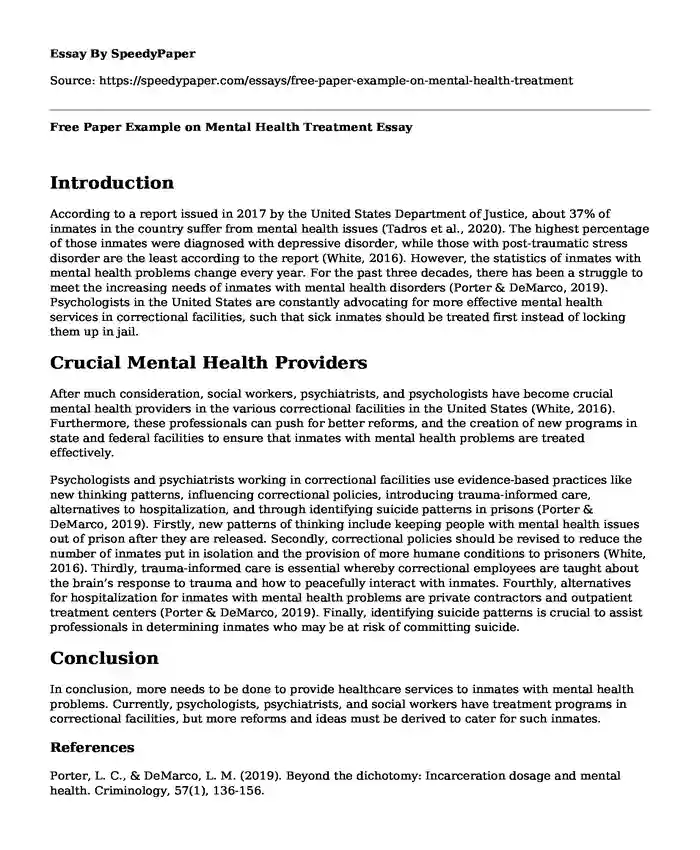
| Type of paper: | Essay |
| Categories: | United States Penal system Mental health |
| Pages: | 2 |
| Wordcount: | 442 words |
Introduction
According to a report issued in 2017 by the United States Department of Justice, about 37% of inmates in the country suffer from mental health issues (Tadros et al., 2020). The highest percentage of those inmates were diagnosed with depressive disorder, while those with post-traumatic stress disorder are the least according to the report (White, 2016). However, the statistics of inmates with mental health problems change every year. For the past three decades, there has been a struggle to meet the increasing needs of inmates with mental health disorders (Porter & DeMarco, 2019). Psychologists in the United States are constantly advocating for more effective mental health services in correctional facilities, such that sick inmates should be treated first instead of locking them up in jail.
Crucial Mental Health Providers
After much consideration, social workers, psychiatrists, and psychologists have become crucial mental health providers in the various correctional facilities in the United States (White, 2016). Furthermore, these professionals can push for better reforms, and the creation of new programs in state and federal facilities to ensure that inmates with mental health problems are treated effectively.
Psychologists and psychiatrists working in correctional facilities use evidence-based practices like new thinking patterns, influencing correctional policies, introducing trauma-informed care, alternatives to hospitalization, and through identifying suicide patterns in prisons (Porter & DeMarco, 2019). Firstly, new patterns of thinking include keeping people with mental health issues out of prison after they are released. Secondly, correctional policies should be revised to reduce the number of inmates put in isolation and the provision of more humane conditions to prisoners (White, 2016). Thirdly, trauma-informed care is essential whereby correctional employees are taught about the brain’s response to trauma and how to peacefully interact with inmates. Fourthly, alternatives for hospitalization for inmates with mental health problems are private contractors and outpatient treatment centers (Porter & DeMarco, 2019). Finally, identifying suicide patterns is crucial to assist professionals in determining inmates who may be at risk of committing suicide.
Conclusion
In conclusion, more needs to be done to provide healthcare services to inmates with mental health problems. Currently, psychologists, psychiatrists, and social workers have treatment programs in correctional facilities, but more reforms and ideas must be derived to cater for such inmates.
References
Porter, L. C., & DeMarco, L. M. (2019). Beyond the dichotomy: Incarceration dosage and mental health. Criminology, 57(1), 136-156.
Tadros, E., Ribera, E., Campbell, O., Kish, H., & Ogden, T. (2020). A Call for Mental Health Treatment in Incarcerated Settings with Transgender Individuals. The American Journal of Family Therapy, 1-14.
White, C. (2016). Incarcerating youth with mental health problems: A focus on the intersection of race, ethnicity, and mental illness. Youth violence and juvenile justice, 14(4), 426-447.
Cite this page
Free Paper Example on Mental Health Treatment. (2023, Nov 10). Retrieved from https://speedypaper.com/essays/free-paper-example-on-mental-health-treatment
Request Removal
If you are the original author of this essay and no longer wish to have it published on the SpeedyPaper website, please click below to request its removal:
- Essay Example on Genetic Diseases
- Ready-to-Download Essay Sample about Government Systems
- Essay Sample: The Impact of GMO in Fifty Years' Time from Now
- Paper Example on the Role of Interferon Response in Containing Human Pathogenic Bourbon Virus
- Paper Example - Creative Cities
- Essay Sample on Pharmaceutical Pricing
- Essay on Capitalism: Economic System Powering US Economy, Politicians' Platforms
Popular categories




